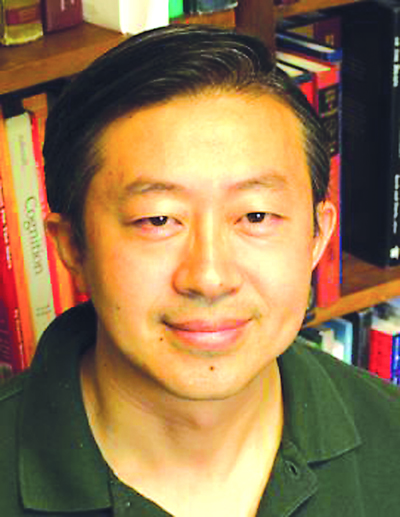
Yi-Yuan Tang said that meditation helps the brain stay organized.
What does it take to become a better thinker? Do you need to meditate for hours and engage in grueling cognitive training? Or could the path to a healthy mind be as simple as walking 40 minutes a day? At a symposium on training, performance, and neuroplasticity at the 24th APS Annual Convention in Chicago, three researchers presented their own methods for improving cognition and for tightening the neural circuits that underlie an efficient mind.
APS Fellow and symposium chair Yi-Yuan Tang, from Texas Tech University, began by discussing his work on integrative body-mind training (IBMT), a meditation technique that he and his colleagues have adapted from traditional Chinese medicine. IBMT combines physical and mental relaxation techniques, ?because you really need to train the body to train the mind,? Tang explained. Using detailed fMRI analysis, Tang has been able to pinpoint the neural changes that underlie meditation-induced improvements in mood and cognitive performance.
Many studies on the effects of meditation examine lifelong meditators who have thousands of hours of practice under their belts, but Tang found positive effects in students who performed IBMT for less than a week. After 20 minutes of meditation a day for five days, the students demonstrated improvements in their conflict-resolution abilities and creative problem solving skills, as well as decreased blood levels of the stress hormone cortisol.
Tang found that patients who had been practicing IBMT longer (two to four weeks) had increased blood flow to the anterior cingulate cortex and insular striatum, two brain regions associated with self-regulation. Additionally, these brain areas had increased white-to-gray matter ratios, suggesting that the detectable changes associated with meditation might be mediated by increased networking in these areas.

Randall W. Engle asked whether task training transfers.
Using a technique known as diffusion tensor imaging, Tang was able to examine neuron-level changes in brain structure with the same basic tools as fMRI. In the cingulate and the striatum, he found a significant increase in fractional anisotropy, which is the extent to which a region?s neurons are all oriented in the same direction. Participants? brains, in effect, were becoming more organized through meditation.
APS Fellow Randall W. Engle, from the Georgia Institute of Technology, focused on a different method for mental improvement. He developed a cognitive training strategy designed to enhance working memory capacity. Using arduous memory tests (and generous financial compensation), Engle trained his participants to become experts at an array of tasks involving working memory. Then, to examine the transfer of their new skills, he asked them to apply their memory skills to other tests.
While other experimenters have had favorable findings using this style of memory training and transfer, Engle wanted to isolate the impact of training on working memory capacity and examine the transfer of memory skills. ?We?ve got to look at what is being trained, and teach people to generalize it,? he explained. Through careful experimental design, he was able to separate skills that are specific to a task from more general working-memory improvements. But what he found in terms of transfer wasn?t so hopeful.
Of course, training can have impressive returns, especially when participants are paid for performing better. Engle showed a sample slide from a task, which looked like a field of meaningless symbols, and asked audience members to point to the letter ?F? hidden among them. Fellow panelist Art Kramer, from University of Illinois at Urbana-Champaign, was the only audience member who found it after 10 seconds, but most participants in Engle?s experiments were able to find the F within 250 milliseconds after they received weeks of training.
However, when participants were asked to transfer their training to a new test, the results weren?t so hopeful. Transfer between similar tasks was simple ? transfer between disparate tasks was not. Engle?s study suggests that task-specific training doesn?t increase working-memory capacity in a way that is meaningfully transferable among different tasks. These negative results could have enormous implications for recent trends in education in which working-memory training is used as a cognitive ?workout? for struggling students.
A mental workout may not be the best approach for enhancing working memory, yet APS Fellow Kramer?s research suggests a physical workout could improve memory. In adults aged 59 to 80, Kramer found that walking 40 minutes a day, three times a week, helped to reverse the effects of age on brain circuits involved in attention and decision making.

Art Kramer found that walking could help reverse the effects of aging.
Some of these brain circuits had been identified in Kramer?s previous studies using a task called Space Fortress that was cobbled together from arcade games. As participants learned how to play the video game, Kramer and colleagues were able to examine the brain circuits involved in training for a complex task. Space Fortress, it turns out, tightened connections in the default mode network, which is associated with resting and undirected thought, as well as the fronto-executive network, which orchestrates complex tasks. Both of these networks are typically weakened in aging populations.
However, the deterioration of these networks might be reversible through exercise. Kramer asked two groups of self-identified ?couch potatoes? to spend a year either walking or stretching three times a week and used fMRI to monitor the strength of brain networks at the beginning of the study, after six months, and after a year. The results were promising. The walking group improved their performance on cognitive tasks and increased the strength of certain brain networks, even to the point in which their brains resembled the brains of much younger people. Kramer also observed increases in hippocampus volume, measures of neural organization, and brain-derived neurotrophic factor in the walking group.
The finding that exercise helps cognition is not new, but Kramer?s attention to the strengthening of networks suggests that the effects of exercise might be based in the same decision-making networks that allow us to play video games.
What can we learn from these disparate lines of research? Taken together, they suggest that cognitive training alone isn?t the secret to improving cognitive function. Instead, strengthening the connections between body and mind through meditation and walking may be the key to a better brain.
house of wax patrick willis team america snow day snow day neti pot iron chef
No comments:
Post a Comment
Note: Only a member of this blog may post a comment.